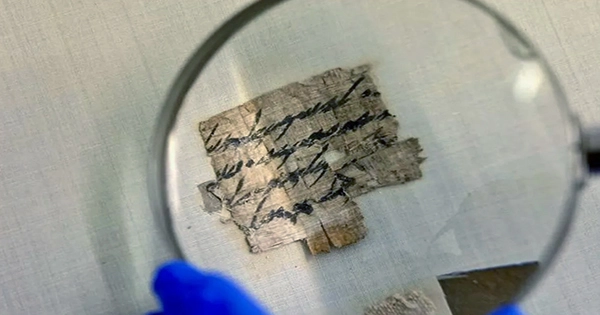After spending 60 years in far colder climates, a rare piece of papyrus, possibly a portion of an ancient letter, has been restored to Israel. The scrap was ultimately lost for nearly three millennia before it was accidentally captured in a photograph and eventually found and recovered. The Israel Antiquities Authority’s (IAA) Dead Sea Scrolls collection only has three papyri from this time period that are known to exist.
According to Joe Uziel, Director of the IAA Judean Desert Scrolls Unit, “First Temple-period documents written on organic materials – such as this papyrus – have hardly survived.” We only have three documents from the First Temple period, including this newly discovered one, but we have hundreds of scroll fragments dating from the Second Temple period.
According to radiocarbon dating performed by the IAA, the history of the papyrus starts around the seventh to sixth century BCE, which fits in well with estimates based on the note’s letter shapes. That puts it right in the center of the First Temple Period, which was so named in honor of the Temple of Solomon, which, according to Jewish tradition, stood in Jerusalem from the 10th century BCE until it was destroyed in 586 BCE.
However, the papyrus doesn’t record a significant Temple document. The piece, which is hardly larger than a postage stamp, is only four ripped lines long. Its introductory words, “To Ishmael send,” give away that it was originally a letter with instructions.
According to Shmuel Ahituv, Professor Emeritus of Ben Gurion University’s department of Bible Studies, Archeology, and the Ancient Near East, “Ishmael… was a common name in the Biblical time, meaning ‘God will hear’.” The following paper most likely attested to a despatch to or from Yishmael.
The arid environment of the Judean Desert, where all three of the First Temple era artifacts were initially discovered, allowed the document to be kept for such a long time. It remained there for a few thousand years before being robbed and sold to nearby antiquities traders at some time, presumably during the last century, according to Uziel.
Midway during the 1960s, the relic traveled from Europe to Montana’s Big Sky region. It is unclear if the woman who brought the papyrus home as a souvenir in 1965 ever obtained the special permits required for the sale and export of antiquities at the time, when the region that is now known as Jerusalem was under Jordanian rule.
Nevertheless, she managed to get it home, where she hung the framed scroll piece. If Ahituv hadn’t found a picture of the relic among the notes of a deceased colleague, it might still have been there.
A cooperative endeavor to locate and return this enigmatic document to Israel was launched by Ahituv and the IAA Antiquities Theft Prevention Unit.
According to Eli Eskosido, director of the Israel Antiquities Authority, “repatriating this unique manuscript is part of an extended process led by the Israel Antiquities Authority, intending… to prevent the unlawful sale of the ancient scrolls that were plundered from the Judean Desert in the past.” On the other side, we also want to stop people from stealing the current cultural artifacts that have been discovered in the desert.
The goal was to persuade the owner to turn over the papyrus fragment to Israeli authorities once it had been located in its new home—now at the house of the buyer’s son from the 1960s. He was persuaded that the priceless document would be best conserved by the antiquities specialists at the lab after receiving an invitation to the Judean Desert Scroll Department’s Conservation Laboratory of the Israel Antiquities Authority in Jerusalem.
Hili Tropper, Israel’s Minister of Culture and Sport, remarked, “The Israel Antiquities Authority…continues to surprise us with their success in uncovering hidden ancient masterpieces. The Israel Antiquities Authority’s Antiquities Theft Prevention Unit works assiduously to eradicate the looting of antiquities so that everyone can appreciate the national heritage and dig deeper into our roots.
The Israel Antiquities Authority’s First Judean Desert Conference will take place at the Bible Lands Museum in Jerusalem on Thursday, and it will feature presentations on the findings of the artifact’s research. For the time being, the fragment joins a variety of artifacts that have been discovered nearby recently, some of which have already changed how we view the evolution of written language and communication.
“Writing was widely used at the end of the First Temple period,” Uziel said. This is proven by numerous discoveries, such as collections of ostraca (documents written on ceramic sherds) and stamp seals containing writing, found in numerous ancient urban settlements, including the royal capital of Jerusalem.
















